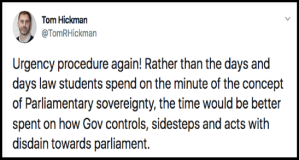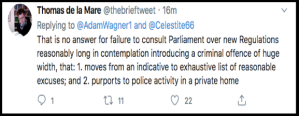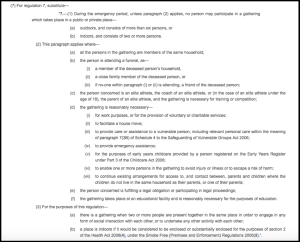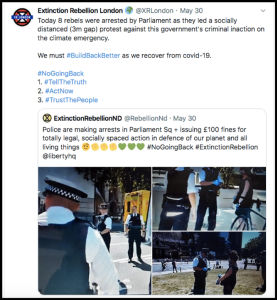Just before Easter, YouGov ran a survey for me. It and the subsequent analysis and writing up have been very generously funded by The Article 11 Trust. That is underway now. As part of the proposal, I committed to making available the “correct” answers, with short explanations of why.
The survey explores public understanding of when a public protest is lawful (i.e. is allowed) in England, what offences/crimes someone risked committing during a protest, and how the police might use their powers.
The survey contained 20 short scenarios of 1-2 lines, for each asking respondents whether they thought the scenario proposition was “definitely true”, “probably true” “I don’t know”, “probably untrue” and “definitely untrue”. Each question asked the respondent’s view of what they think the law is. It was not a survey designed to test what they thought the law should be.
- Someone who organises a group to stand and protest outside the town hall against the council’s planned budget cuts is required to notify the police.
This is NOT TRUE. There is no requirement in English law to notify the police of a static assembly. There is a requirement to give six days’ notice of some marches to the police, including almost any protest march. Giving notice though is not the same as seeking permission – no one, for a march or assembly, needs permission to protest.
2. The police are allowed to photograph anyone who takes part in a protest in a public place.
This is TRUE. There are no restrictions on the police taking photos of us in public, in the same way as there are none on us as private citizens. They need no separate lawful authority, like a warrant. That is not necessarily the same if the police record, or film, or use face recognition technology (FRT).
3. At a demonstration, the police are allowed to arrest anyone for refusing to provide their name or address.
This is NOT TRUE. There is no obligation under English law to tell the police such details and so no power of arrest for “obstructing the police in the execution of their duty” and nor is there any specific power in the Police and Criminal Evidence Act 1984 which in s.24 sets out very clear grounds, or reasons, for the police if they wish to arrest.
4. There is a specific crime in English law of destroying the flag of any country or the sacred symbols of any religion.
This is NOT TRUE. There is no such specific crime in English law though it is possible that it might give rise to arrest for another more general offence – criminal damage or using threatening behaviour to harass, alarm or distress.
5. The police have the power to use reasonable force to arrest protesters for committing any crime, or to try to make them obey their orders.
This is TRUE. Under s.117 of the Police and Criminal Evidence Act 1984 may use reasonable force, if necessary, in the exercise of their other, general powers.
6. The police are required by law to protect peaceful protesters from violent disruption.
This is TRUE. As a matter of both European and UK human rights law, the police have two duties. One, not disproportionately to interfere with the right to protest peacefully, and two a positive duty or obligation to take steps to facilitate that right. This will include protecting one, peaceful, group from a violent group trying to close them down.
7. In English law, we all have the right to protest peacefully even, in some circumstances, when we break the law.
This is TRUE. Again, as a matter of both European and UK human rights law, the right to protest peacefully includes protests that are disruptive or obstructive as long as they are not violent or do not demonstrate violent intentions. This right extends therefore to some protests where protesters break the law provided they remain peaceful. This does not mean they cannot ever be arrested, but that the police must show they are acting ‘proportionately’ if they decide to.
8. You cannot commit criminal damage if you only use chalk to write a political message on the pavement outside your local Town Hall.
This is NOT TRUE. The definition of what constitutes criminal damage under the Criminal Damage Act 1971 is very wide. Courts have determined it can include cases where property suffers some permanent or temporary physical harm or impairment of use or value. It does not need to be serious, severe or even more than minimal, and has included prosecutions for using of water soluble paint to outline dead bodies of those who died at Hiroshima, because even though the rain would have washed it away, the council was put to expense to rectify the matter.
9. Police officers have a power to impose conditions such as limiting the number of people at a protest if they reasonably believe there might be significant noise disruption.
This is TRUE. Under provisions in the Police Crime Sentencing and Courts Act 2022, the police now have powers to impose conditions on marches and assemblies, even those yet to or just about to take place, if they reasonably believe that the noise may seriously disrupt the activities of an organisation in the vicinity OR may have a significant impact through, for example, resulting in intimidation or harassment or causing alarm or distress. This was added to the existing “triggers” to exercise the power to impose conditions – serious damage to property, serious public disorder, and serious disruption to the life of the community.
10. A handful of people staging a short sit-in on the road, and who block entry to a petrol station, are likely to be committing the crime of wilfully obstructing the highway but may have a lawful excuse for doing so.
This is TRUE. It is an offence under s.137 of the Highway Act 1980 wilfully, so intentionally, to obstruct the highway – which includes the pavement. It does not matter, in law, how short lived or how little the disruption is, or whether it is only partial – so that someone can pass along some parts of the pavement. BUT, if you have a lawful excuse to obstruct, you will not have committed the offence, an obvious example being a breakdown or running out of petrol. But, in an important case in 2021, the UK Supreme Court decided that a lawful excuse could in some situations include exercising the right to peaceful protest, albeit disruptively.
11. Protesters who sing nasty, foul chants can be arrested for the specific crime of causing offence to others in a public place.
This is NOT TRUE. There is no crime in English law of simply giving offence or being offensive to others, whether in public or private. It needs something more, for example using threatening or abusive language where someone is likely to be caused harassment, alarm, or distress.
12. “Controversial” demonstrations – defined as those likely to provoke anger or ill-will among the majority – require advance notice to the police.
This is NOT TRUE. There is no law giving police the power to control or regulate protests – marches or demonstrations – simply because they are controversial, and no law requiring us to give any notice at all on that ground. The police may have power to impose conditions on the day or in advance on other grounds (see Q9) or because they reasonably apprehend an imminent breach of the peace, but not a power simply because the topic or speaker is “controversial”.
13. If someone else threatens violence because of a provocative placard you are holding at a protest, the police have the power to arrest you to prevent a breach of the peace.
This is TRUE. The power to regulate protests at the time or in advance on grounds that there is a reasonably anticipated, imminent breach of the peace is very wide. Breach of the peace is not defined in an Act, a statute but by judges at common law and (broadly) involves and requires violence to someone or, in their presence, to their property. Usually, the police will be under a duty to take action against the person threatening violence but the courts have decided that they need not always, every time, do so. In such cases the question is this: was X being so provocative that someone in the crowd, without behaving wholly unreasonably, might be moved to violence? Or were passers-by taking the opportunity to react so as to cause trouble?
14. The police are allowed to arrest anyone who takes part in a march or demonstration which they should have known was in breach of police conditions.
This is TRUE. In a change introduced in 2022, it is now an offence to take part in a protest march or demonstration if someone knew or ought to have known it was in breach of police conditions imposed (see Q9).
15. A local business owner can sue protesters for damages representing loss of trade if, as part of their targeted campaign, they successfully persuade existing suppliers not to deliver.
This is TRUE. The business owner can sue P for the economic tort of inducing breach of contract, on the basis that existing suppliers must be in some form of continuing contractual relationship with the business, and (assuming) the protesters are acting knowingly and intentionally. If so, they can sue for the losses or damages they suffer as a direct result.
16. If a protest group wants to hold a march through a town, they are responsible for organising for the roads to be closed, and paying for that, not the local council or the police.
This is NOT TRUE. The duty or obligations are ones that fall on the state, that is the police or council as part of their duties, under European and English human rights law and principles, to “facilitate” the right of peaceful protest.
17. The Public Order Act 2023 allows a court to ban you from visiting another protest site or meeting other named protesters if, in a five-year period, you are found guilty for a second time of a “protest related” crime.
This is TRUE. Provisions in the 2023 Act allow magistrates to impose “Serious Disruption Prevention Orders” on anyone aged over 18 and convicted in the past five years of an earlier, previous “protest-related” crime, something not defined more clearly in the Act. They can last for up to two years and can cover restrictions such as banning a protester from a specific place, from being with particular people, from having particular articles with them, or from using the internet if such a ban can be shown to be necessary to prevent them from causing or contributing to the commission by them or by someone else of a protest related offence or breach of an injunction, or to protect two or more other people from the risk of serious disruption arising from a protest-related offence. They came into force in early April. Other provisions allow magistrates to impose such an order on someone who has not been on trial, or been convicted before them, simply on the basis that they have committed two protest-related offences in the past five years.
18. If the police want to stop and search protesters, they always need to have reasonable suspicions about them or what they plan to do.
This is NOT TRUE. While in general the police need reasonable suspicion of you that they will find stolen or prohibited items, or items for use in burglary or robbery, or drugs before they can exercise their power to stop and search, in some cases they need no reasonable suspicion particular to you in order to stop and search. Under provisions in the Public Order Act 2023, if a police inspector reasonably believes that certain protest offences may be committed in the area – such as obstruction of the highway (Q10), public nuisance, or locking on (among others) – they may authorise stop and search powers to be exercised without any reasonable suspicion of any individual for a period of up to 24 hours.
19. The police need a warrant or court order to look at a protester’s social media accounts on Facebook, Instagram, or Twitter.
This is NOT TRUE. Just like taking photos (Q2) the police need no special power to look at “open source” i.e. publicly available social media posts. They do not need a warrant, court order, or even any reasonable suspicion.
20. The police have the power to arrest anyone cycling to a protest, and carrying a big bike lock, for the crime of going equipped to cause serious disruption by locking-on.
This is TRUE. It is now an offence under the Public Order Act 2023, to lock on – that is attach yourself to someone else, to another object or to land, or to attach an object to land, or to attach two people together – with the intention of causing serious disruption to two or more other people, or to an organisation, and also an offence to “go equipped” to lock on. There is no minimum period that the attachment needs to last, no permanence and no sense of minimum level of how secure it must be. It would be for the protester to prove they had a reasonable excuse for carrying the lock. The police have a general power, under the Police and Criminal Evidence Act 1984, to arrest anyone whom they reasonably suspect is or has or will be committing any offence, including therefore any of those.




